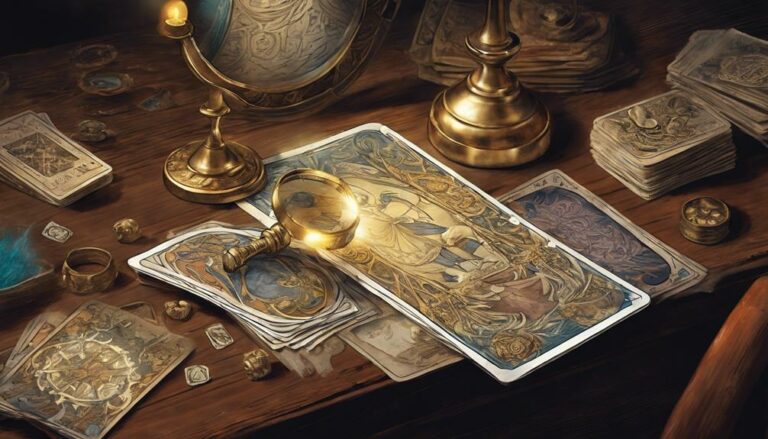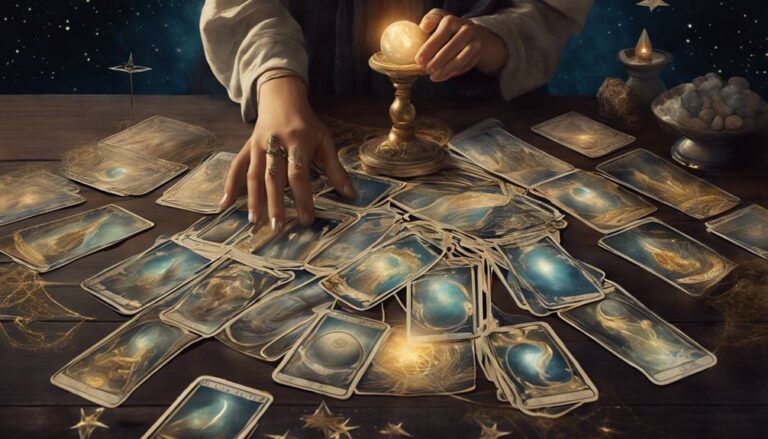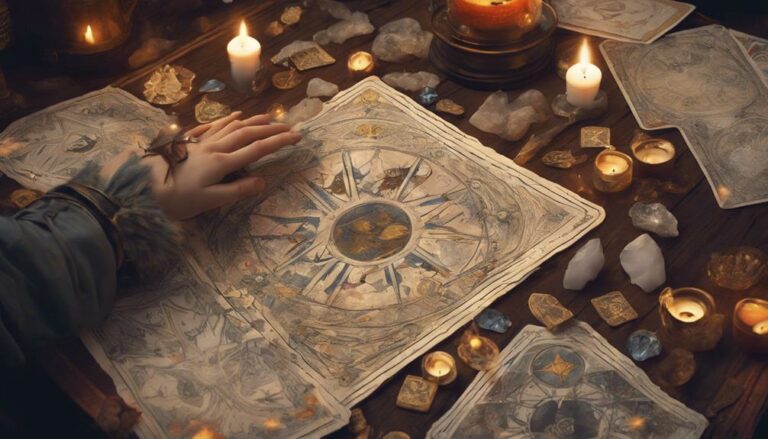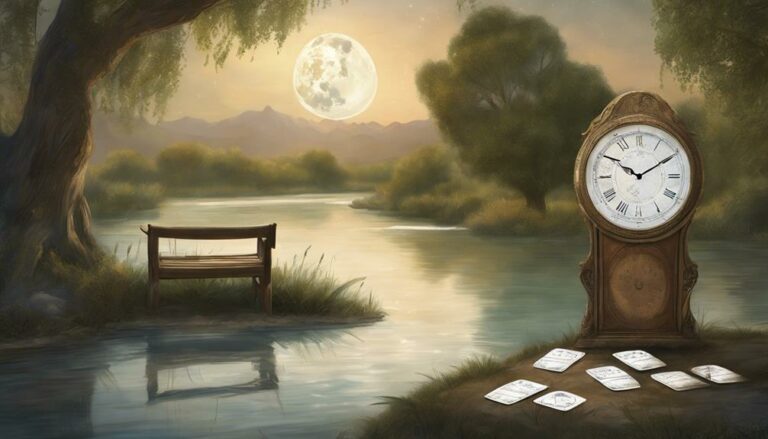Table of Contents
As an avid tarot enthusiast, I have always been fascinated by the rich tapestry of symbolism and meanings embedded within the cards. Now, I invite you to embark on a journey with me as we delve into the intriguing realm of cross-cultural tarot symbolism and meanings. In this article, we will explore the origins of tarot symbolism, uncover hidden layers of meaning, and analyze how different cultures have influenced and interpreted the cards. Get ready to broaden your understanding and deepen your tarot practice as we uncover the interconnectedness of tarot across cultures.
Key Takeaways
- Tarot cards draw from Egyptian, Jewish, and Christian traditions for their symbolism.
- Different cultures infuse their own cultural significance into tarot cards, such as the Egyptian tarot deck including symbols like the Ankh and the Eye of Horus.
- Cross-cultural interpretations offer diverse perspectives on tarot cards, reflecting cultural values and beliefs.
- Tarot cards provide insights into the mysteries and spiritual heritage of different cultures.
The Origins of Tarot Symbolism
You’ll be interested to learn about the origins of tarot symbolism and how it has evolved over time. The origins of tarot cards can be traced back to the 15th century in Europe. Originally, tarot cards were used for playing games, but they soon gained spiritual and mystical significance. The historical significance of tarot symbolism lies in its ability to tap into the collective unconscious and provide insights into the human experience.
The tarot deck consists of 78 cards, divided into two main categories: the Major Arcana and the Minor Arcana. The Major Arcana consists of 22 cards, each representing a major life lesson or archetypal experience. The Minor Arcana consists of 56 cards, divided into four suits (Wands, Cups, Swords, and Pentacles), each representing a different aspect of life.

The symbolism found in tarot cards draws from various cultural and religious traditions, including Egyptian, Jewish, and Christian symbolism. For example, the High Priestess card is often associated with the Egyptian goddess Isis, while the Strength card is linked to the biblical figure of Samson. These diverse influences contribute to the richness and depth of tarot symbolism.
Over time, tarot symbolism has evolved and adapted to different cultural contexts. Today, tarot cards are used for divination, self-reflection, and personal growth. The symbols and meanings associated with each card continue to resonate with people from all walks of life, offering guidance and insight into the human condition.
Exploring Cultural Influences on Tarot Meanings
When exploring cultural influences on tarot, it’s important to consider how different societies shape the interpretations of the cards. Cultural diversity in tarot interpretations highlights the fascinating impact of cultural beliefs on tarot symbolism. Here are three examples that illustrate this influence:
- In Egyptian culture, the tarot card “The High Priestess” may be seen as the embodiment of the goddess Isis. This interpretation adds a layer of mysticism and divine feminine energy to the card, emphasizing the importance of intuition and hidden knowledge.
- In Chinese culture, the tarot card “The Emperor” may be associated with the concept of the Mandate of Heaven, where a ruler’s legitimacy is believed to come from divine approval. This interpretation infuses the card with notions of power, authority, and the responsibility to govern wisely.
- In Native American cultures, the tarot card “The Fool” may be connected to the trickster archetype, symbolizing the importance of spontaneity, humor, and the willingness to take risks. This interpretation adds a sense of playfulness and unpredictability to the card’s meaning.
These examples demonstrate how cultural beliefs and perspectives can shape the interpretations of tarot cards, giving them depth and nuance. By embracing cultural diversity in tarot interpretations, we gain a richer understanding of the symbolism and meanings behind the cards.

Unearthing Hidden Symbolism in Tarot Cards
Unearthing hidden symbolism in tarot cards can reveal deeper layers of meaning and enhance our understanding of the cards. Tarot cards are not simply a tool for divination; they are also repositories of ancient wisdom and universal archetypes. By decoding the symbols and imagery within the cards, we can tap into a wealth of knowledge that spans across cultures and centuries.
To illustrate the power of uncovering hidden symbolism, let’s examine a popular tarot card: The High Priestess. In the table below, I have listed some of the key symbols found in this card and their deeper meanings:
| Symbol | Meaning |
|---|---|
| Moon | Intuition, mystery, femininity |
| Pillars | Balance, duality, hidden knowledge |
| Veil | Hidden truths, secrets, the subconscious |
By understanding these symbols, we can gain insight into the deeper meaning of The High Priestess card. It represents the unveiling of hidden knowledge, the power of intuition, and the exploration of the subconscious. This card serves as a reminder to trust our instincts and delve into the depths of our inner wisdom.
Unearthing hidden symbolism in tarot cards allows us to connect with ancient wisdom and decode universal archetypes. It enables us to access a deeper level of understanding and meaning, enhancing our readings and personal growth. So, let’s dive into the rich tapestry of tarot symbolism and unlock the secrets that lie within.
Comparative Analysis of Tarot Symbolism Across Cultures
Explore how different cultures compare in their use of symbols and imagery within tarot cards, revealing unique perspectives and interpretations. Tarot cards have a significant role in various cultures around the world, each infusing their own cultural significance and symbolic interpretation into the cards.
- The Egyptian tarot deck transports us to the land of pharaohs and pyramids, where symbols like the Ankh represent life and the Eye of Horus symbolizes protection and healing. These cards tap into the ancient wisdom of Egypt, providing insights into the mysteries of the universe.
- In the Celtic tarot tradition, one can find symbols like the triskele, representing the cycle of life, death, and rebirth, and the Celtic knot, symbolizing the interconnectedness of all things. These cards offer a glimpse into the rich folklore and spiritual heritage of the Celtic people.
- The Japanese tarot deck, influenced by Shinto and Buddhist traditions, incorporates symbols like the cherry blossom, representing beauty and impermanence, and the dragon, symbolizing wisdom and power. These cards provide a unique perspective on the delicate balance between nature and spirituality in Japanese culture.

Interpreting Cross-Cultural Tarot Meanings
To gain a deeper understanding of how different cultures interpret tarot cards, you can examine the unique meanings and interpretations they assign to the symbols and imagery. Cross-cultural interpretations of tarot cards provide fascinating insights into the diverse ways people perceive and interpret the world around them.
One interesting aspect of cross-cultural tarot interpretations is the role of intuition in tarot readings. While some cultures emphasize the intuitive aspect of tarot readings, others may rely more on structured systems and traditional meanings. For example, in Western cultures, intuition plays a significant role in tarot readings. Readers often rely on their inner knowing and connection to the cards to provide guidance and insight. On the other hand, in Eastern cultures, such as China and Japan, tarot cards are often interpreted in line with traditional divination methods, such as the I Ching or astrology.
Understanding cross-cultural interpretations of tarot cards can also shed light on the cultural values and beliefs of different societies. For instance, the way a symbol is interpreted in one culture may be vastly different from how it is interpreted in another. This demonstrates the rich tapestry of human experiences and the various lenses through which we view the world.
Frequently Asked Questions
How Can I Learn to Read Tarot Cards?
I can learn to read tarot cards by studying the meanings of each card, understanding how to interpret their combinations, and by honing my intuition. It’s important to trust my instincts in tarot readings.
What Is the Significance of the Different Suits in Tarot?
The significance of the different tarot suits lies in their unique symbolism and meanings. Each suit represents a different aspect of life, such as emotions, intellect, or material wealth. Across cultures, these symbols may vary, adding depth and diversity to tarot interpretations.
Are There Specific Tarot Spreads for Cross-Cultural Readings?
Yes, there are specific tarot spreads that can be used for cross-cultural readings. These spreads are designed to incorporate symbols and meanings from different cultures, allowing for a more comprehensive and diverse interpretation.
Can Tarot Card Meanings Vary Within Different Cultures?
Yes, tarot card meanings can vary within different cultures. Cultural influences play a significant role in shaping the interpretation of the cards. One’s cultural background can impact how they perceive and understand the symbols and messages in the tarot.
How Do I Choose a Tarot Deck That Resonates With Me?
When choosing a tarot deck, it’s essential to find one that resonates with your intuition and aligns with your personal beliefs. Consider factors such as artwork style, symbolism, and the deck’s energy to ensure a meaningful connection.
Conclusion
As I reflect on the fascinating world of cross-cultural tarot symbolism and meanings, I am reminded of a tapestry woven with threads of diverse cultures and ancient wisdom. Like a skilled tarot reader, we have delved into the origins and explored the cultural influences that shape the meanings of each card. We have unearthed hidden symbolism, revealing the interconnectedness of different cultures through the universal language of tarot. Through comparative analysis, we have gained a deeper understanding of the rich tapestry of cross-cultural tarot meanings. It is through this lens that we can interpret the messages of the cards, allowing us to connect with the collective wisdom of humanity. Just as the cards guide us on our personal journeys, cross-cultural tarot symbolism guides us on a journey of cultural exploration and self-discovery.










